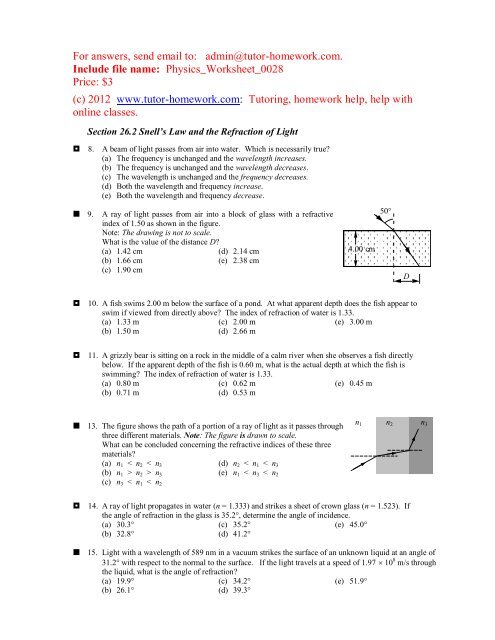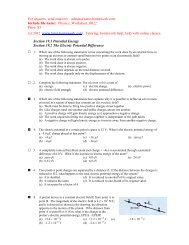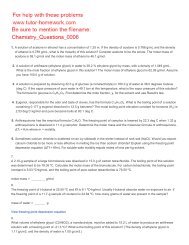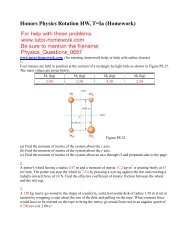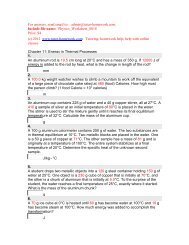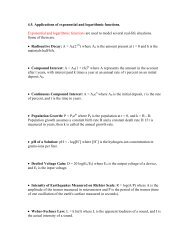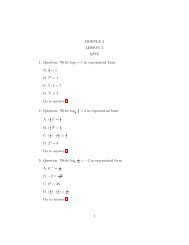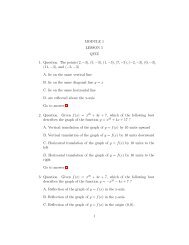For answers, send email to - Tutor-Homework.com
For answers, send email to - Tutor-Homework.com
For answers, send email to - Tutor-Homework.com
Create successful ePaper yourself
Turn your PDF publications into a flip-book with our unique Google optimized e-Paper software.
<strong>For</strong> <strong>answers</strong>, <strong>send</strong> <strong>email</strong> <strong>to</strong>: admin@tu<strong>to</strong>r-homework.<strong>com</strong>.Include file name: Physics_Worksheet_0028Price: $3(c) 2012 www.tu<strong>to</strong>r-homework.<strong>com</strong>: Tu<strong>to</strong>ring, homework help, help withonline classes.Section 26.2 Snell’s Law and the Refraction of Light 8. A beam of light passes from air in<strong>to</strong> water. Which is necessarily true?(a) The frequency is unchanged and the wavelength increases.(b) The frequency is unchanged and the wavelength decreases.(c) The wavelength is unchanged and the frequency decreases.(d) Both the wavelength and frequency increase.(e) Both the wavelength and frequency decrease.• 9.A ray of light passes from air in<strong>to</strong> a block of glass with a refractiveindex of 1.50 as shown in the figure.Note: The drawing is not <strong>to</strong> scale.What is the value of the distance D?(a) 1.42 cm(d) 2.14 cm(b) 1.66 cm(e) 2.38 cm(c) 1.90 cm4.00 cm50°D 10. A fish swims 2.00 m below the surface of a pond. At what apparent depth does the fish appear <strong>to</strong>swim if viewed from directly above? The index of refraction of water is 1.33.(a) 1.33 m (c) 2.00 m (e) 3.00 m(b) 1.50 m(d) 2.66 m 11. A grizzly bear is sitting on a rock in the middle of a calm river when she observes a fish directlybelow. If the apparent depth of the fish is 0.60 m, what is the actual depth at which the fish isswimming? The index of refraction of water is 1.33.(a) 0.80 m (c) 0.62 m (e) 0.45 m(b) 0.71 m(d) 0.53 m• 13. The figure shows the path of a portion of a ray of light as it passes throughthree different materials. Note: The figure is drawn <strong>to</strong> scale.What can be concluded concerning the refractive indices of these threematerials?(a) n 1 < n 2 < n 3 (d) n 2 < n 1 < n 3(b) n 1 > n 2 > n 3 (e) n 1 < n 3 < n 2(c) n 3 < n 1 < n 2n 1 n 2 n 3 14. A ray of light propagates in water (n = 1.333) and strikes a sheet of crown glass (n = 1.523). Ifthe angle of refraction in the glass is 35.2°, determine the angle of incidence.(a) 30.3° (c) 35.2° (e) 45.0°(b) 32.8° (d) 41.2°• 15. Light with a wavelength of 589 nm in a vacuum strikes the surface of an unknown liquid at an angle of31.2° with respect <strong>to</strong> the normal <strong>to</strong> the surface. If the light travels at a speed of 1.97 10 8 m/s throughthe liquid, what is the angle of refraction?(a) 19.9° (c) 34.2° (e) 51.9°(b) 26.1° (d) 39.3°
262 Chapter 26 Refraction of Light: Lenses and Optical InstrumentsQuestions 16 and 17 pertain <strong>to</strong> the statement and diagram below:The figure shows the path of a ray of light asit travels through air and crosses a boundaryin<strong>to</strong> water. The index of refraction of waterfor this light is 1.33.30°60°airwater 16. What is the speed of this ray of light as it travels through the water?(a) 1.54 10 8 m/s (c) 2.86 10 8 m/s (e) 4.43 10 9 m/s(b) 2.26 10 8 m/s(d) 3.99 10 8 m/s 17. What is the angle of refraction for this situation?(a) 0.37° (c) 22° (e) 60°(b) 0.65° (d) 41°Section 26.3 Total Internal Reflection 18. Complete the following statement: Fiber optics make use of(a) <strong>to</strong>tal internal reflection. (c) chromatic aberration. (e) dispersion.(b) polarization.(d) Brewster's angle. 19. Which one of the following expressions determines the critical angle for quartz (n = 1.5)immersed in oil (n = 1.1)?(a) c = 1.5/1.1 (c) c = sin 1 (1.1/1.5) (e) c = tan 1 (1.1/1.5)(b) c = 1.5/1.1 (d) c = sin (1.1/1.5)• 20. A ray of light originates in medium A and is incident upon medium B. <strong>For</strong> which one of thefollowing pairs of indices of refraction for A and B is <strong>to</strong>tal internal reflection not possible?n A n B(a) 1.36 1.00(b) 1.26 1.15(c) 2.54 1.63(d) 1.28 1.36(e) 1.12 1.06• 21. A glass block with an index of refraction of 1.7 isimmersed in an unknown liquid. A ray of light insidethe block undergoes <strong>to</strong>tal internal reflection as shown inthe figure. Which one of the following relations bestindicates what may be concluded concerning the indexof refraction of the liquid, n L?40° 40°50° 50°(a) n < 1.0 L(b) n L≥ 1.1 (c) n ≥ 1.3 L(d) n L≤ 1.1(e) n ≤ 1.3 L 22. A light ray is traveling in a diamond (n = 2.419). If the ray approaches the diamond-air interface,what is the minimum angle of incidence that will result in all of the light reflected back in<strong>to</strong> thediamond? The index of refraction for air is 1.000.(a) 24.42° (c) 54.25° (e) 77.54°(b) 32.46° (d) 65.58°
Physics, 7e TEST BANK 265(a) 8.6 cm (c) 20 cm (e) 50 cm(b) 13 cm(d) 30 cm• 45. When an object is placed 25 cm from a lens, a real image is formed. Which one of the followingconclusions is incorrect?(a) The image is upright.(b) The lens is a converging lens.(c) The image may be reduced or enlarged.(d) The image distance can be less than 25 cm.(e) The focal length of the lens is less than 25 cm.• 46. When an object is placed 15 cm from a lens, a virtual image is formed. Which one of thefollowing conclusions is incorrect?(a) The lens may be a convex or concave.(b) If the image is upright the lens must be a diverging lens.(c) If the image is reduced, the lens must be a diverging lens.(d) If the lens is a diverging lens, the image distance must be less than 15 cm.(e) If the lens is a converging lens, the focal length must be greater than 15 cm.• 47. When an object is placed 20 cm from a diverging lens, a reduced image is formed. Which one ofthe following statements is necessarily true?(a) The image is inverted.(b) The image could be real.(c) The image distance must be greater than 20 cm.(d) The focal length of the lens may be less than 20 cm.(e) The refractive power of the lens must be greater than 0.05 diopters. 48. A 6.0-cm object is placed 30.0 cm from a lens. The resulting image height has a magnitude of2.0 cm; and the image is inverted. What is the focal length of the lens?(a) 7.5 cm (c) 22.5 cm (e) 45.0 cm(b) 15.0 cm(d) 30.0 cm 49. A converging lens with a focal length of 12 cm produces a 3-cm high virtual image of a 1-cmhigh object. Which entry in the table below is correct?image distance location of image(a) 8 cm same side of lens as object(b) 8 cm opposite side of lens from object(c) 12 cm opposite side of lens from object(d) 24 cm opposite side of lens from object(e) 24 cm same side of lens as object• 50. A camera with a focal length of 0.0500 m (a 50-mm lens) is focused for an object at infinity. Tofocus the camera on a subject which is 4.00 m away, how should the lens be moved?(a) 1.0 cm closer <strong>to</strong> the film(d) 0.06 cm farther from the film(b) 0.06 cm closer <strong>to</strong> the film(e) 4.94 cm farther from the film(c) 4.94 cm closer <strong>to</strong> the film 51. A 4-cm object is placed in front of a converging lens of focal length 20 cm. The image is formed60 cm on the other side of the lens. Which entry in the table below is correct?object distance magnitude of the image height(a) 15 cm 2 cm(b) 15 cm 4 cm(c) 30 cm 4 cm(d) 30 cm 8 cm
266 Chapter 26 Refraction of Light: Lenses and Optical Instruments(e) 60 cm 2 cm 52. A 2.00-cm tall object is placed 40.0 cm from a lens. The resulting image is 8.00-cm tall andupright relative <strong>to</strong> the object. Determine the focal length of the lens.(a) 26.6 cm (c) 53.3 cm (e) 80.0 cm(b) 32.0 cm(d) 64.0 cm• 53. In a slide projec<strong>to</strong>r, the slide is illuminated; and light passing through the slide then passesthrough a converging lens of focal length 0.10 m. If a screen is placed 5.0 m from the lens, asharp image is observed. How far is the slide from the lens?(a) 0.082 m (c) 0.50 m (e) 0.10 m(b) 0.050 m(d) 0.27 m• 54. Joseph uses a converging lens (f = 0.12 m) <strong>to</strong> read a map located 0.080 m from the lens. What isthe magnification of the lens?(a) +3.4 (c) +1.7 (e) +0.33(b) +3.0 (d) +0.60Questions 55 through 58 pertain <strong>to</strong> the statement anddiagram below:The figure is a scaled diagram of an object and aconverging lens surrounded by air. Only one focalpoint, F, of the lens is shown.FA B C D E 55. At which of the labeled points will the image beformed?(a) A(d) D(b) B(e) E(c) C 56. Which pair of terms most accurately describes the image?(a) real, upright (c) virtual, upright (e) virtual, reduced(b) real, inverted(d) virtual, inverted• 57. The index of refraction of this lens is 1.51 for red light and 1.53 for blue light. Blue light isfocused at the point F. Which one of the following statements is true concerning the focalpoint for red light?(a) It is also at F. (d) It is <strong>to</strong> the left of and close <strong>to</strong> F.(b) It is very close <strong>to</strong> D. (e) It is <strong>to</strong> the right of and close <strong>to</strong> F.(c) It is very close <strong>to</strong> the lens.• 58. The system is immersed in a fluid other than air that has an index of refraction that is larger thanthat of the lens. Which one of the following statements is true concerning this new situation?(a) The image will be real.(b) The image will be inverted.(c) The image will be enlarged relative <strong>to</strong> the object.(d) The image will be formed on the same side of the lens as the object.(e) The lens may act as a diverging lens or a converging lens depending on the location of theobject.Questions 59 through 61 refer <strong>to</strong> the statement below:
Physics, 7e TEST BANK 267A diverging lens has a focal length of –10 cm. A 3-cm object is placed 25 cm from the lens.• 59. Determine the approximate distance between the object and the image.(a) 7 cm (c) 18 cm (e) 35 cm(b) 10 cm(d) 32 cm 60. What is the magnification of the image?(a) +0.3 (c) +0.7 (e) +0.8(b) –0.3 (d) –0.7 61. Which pair of terms most accurately describes the image?(a) real, upright (c) real, inverted (e) real, reduced(b) virtual, upright(d) virtual, invertedQuestions 62 through 64 pertain <strong>to</strong> the statementand diagram below:A 4.0-cm object is placed 30.0 cm from a converginglens that has a focal length of 10.0 cm as shown in thediagram. Note: The diagram is not drawn <strong>to</strong> scale.ObjectFLens 62. Where is the image located?(a) 15 cm <strong>to</strong> the left of the lens(d)of the lens(b) 7.5 cm <strong>to</strong> the left of the lens(c) 7.5 cm <strong>to</strong> the right of the lens10.0 cm30.0 cm15 cm <strong>to</strong> the right(e) 30 cm <strong>to</strong> the right of the lens 63. Determine the height and orientation of the image.(a) 2 cm and upright (c) 2 cm and inverted (e) 8 cm and inverted(b) 1 cm and inverted(d) 8 cm and upright• 64. A second converging lens is placed 20.0 cm <strong>to</strong> the right of the lens shown in the figure.Determine the focal length of the second lens if an inverted image (relative <strong>to</strong> the object in thediagram) is formed 13.3 cm <strong>to</strong> the right of the first lens.(a) 1.33 cm (c) 13.3 cm (e) 19.7 cm(b) 6.67 cm(d) 15.4 cmQuestions 65 through 67 pertain <strong>to</strong> the statement and diagram below:The figure is a scaleddiagram of a an object anda converging lens. Thefocal length of the lens is5.0 units. An object isplaced 3.0 units from thelens as shown. 65. Approximately, what is the image distance?(a) 2.0 units (c) +6.0 units (e) +9.0 units(b) 4.0 units(d) 7.5 unitsFObjectLens 66. The object has a height of 1.5 units. What is the approximate height of the image?
268 Chapter 26 Refraction of Light: Lenses and Optical Instruments(a) 2.0 units (c) 5.0 units (e) 9.8 units(b) 1.2 units(d) 3.8 units 67. Which pair of terms most accurately describes the image?(a) real, upright (c) real, inverted (e) virtual, upright(b) real, enlarged(d) virtual, invertedSection 26.10 The Human Eye 75. An object is placed 15 cm from a converging lens with a 5.0-diopter refractive power. At whatdistance from the object will the image be located?(a) 15 cm (c) 45 cm (e) 75 cm(b) 20 cm(d) 60 cm 76. Rachel has a far point of 5 m. Which statement below concerning Rachel’s vision is true?(a) She has normal vision.(b) She is myopic and requires diverging lenses <strong>to</strong> correct her vision.(c) She is myopic and requires converging lenses <strong>to</strong> correct her vision.(d) She is hyperopic and requires diverging lenses <strong>to</strong> correct her vision.(e) She is hyperopic and requires converging lenses <strong>to</strong> correct her vision.• 77. Without his contact lenses, Mr. Zheng can focus from 0.80 m <strong>to</strong> infinity. What refractive powerof the lenses does he require for normal reading (0.25 m from the eyes)?(a) 1.25 diopters (c) 4.00 diopters (e) –5.25 diopters(b) 2.75 diopters(d) 5.25 diopters• 78. The right lens of Josh's contact lenses is a converging lens of +2.50 diopters. He can reada book held as close as 25 cm from his eyes. Without his lenses, Josh's right eye has(a) a far point of 15.4 cm.(d) a near point of 15.4 cm.(b) a far point of 40.0 cm.(e) a near point of 66.7 cm.(c) a far point of 66.7 cm.• 79. Mrs. York has been prescribed eyeglasses with lenses that have a +3.2-diopter refractive power.The glasses are worn 2.0 cm from her eyes. With the lenses, she can read a magazine held 25 cmfrom her eyes. Which one of the following statements is necessarily true?Note: The near points and far points given in the following <strong>answers</strong> are measured relative <strong>to</strong> her eye.(a) She has a far point of 3.2 m. (d) She has a near point of 6.4 m.(b) She has a far point of 0.25 m. (e) She has a near point of 0.87 m.(c) She has a near point of 3.2 m• 80. Matthew's near point is 20.0 cm and his far point is 2.0 m. His contact lenses are designed so thathe can see objects that are infinitely far away. What is the closest distance that he can see anobject clearly when he wears his contacts?(a) 18 cm (c) 25 cm (e) 180 cm(b) 22 cm(d) 75 cm 81. In a scene from a movie, a nearsighted character removes his eyeglasses and uses them <strong>to</strong> focusthe nearly parallel rays of the sun <strong>to</strong> start a fire. What is physically wrong with this scene?(a) The eyeglasses have diverging lenses and cannot be used <strong>to</strong> focus parallel rays.(b) The eyeglasses have converging lenses and cannot be used <strong>to</strong> focus parallel rays.(c) Sunlight cannot be used <strong>to</strong> start a fire.
Physics, 7e TEST BANK 269(d) A fire can only be started if the image is virtual.(e) Parallel rays cannot be focused.• 82. Light that is incident upon the eye is refracted several times before it reaches the retina. As lightpasses through the eye, at which boundary does the majority of the overall refraction occur?(a) lens/aqueous humor (c) lens/vitreous humor (e) vitreous humor/retina(b) air/cornea(d) aqueous humor/iris


